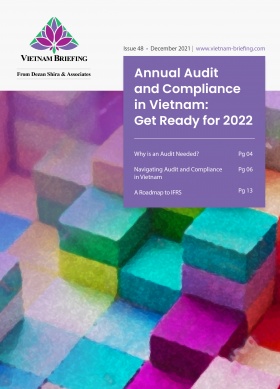IFRS and VAS Part 2: Presentation of Balance Sheet
Contributed by Vinh Le, Manager, Corporate Accounting Services
In part two of this three-part series, Vietnam Briefing introduces the impact of the differences between IFRS and VAS on the presentation of balance sheets. Part 1 can be viewed here.
International Financial Reporting Standards (IFRS) are global accounting standards issued and regulated by the International Accounting Standard Board (IASB) to guide the preparation and presentation of financial reports. Vietnam uses IFRS as a basis for its own system, the Vietnamese Accounting Standards (VAS), yet there are key differences between the two.
IFRS and VAS both require a balance sheet as part of a company’s financial statements. A balance sheet reflects an enterprise’s financial situation, including assets, liabilities, and owners’ equity, at a particular time of the company’s fiscal year. Some balance sheet items are stipulated differently according to IFRS and VAS, which are specified as follows.
Inventories
Compared with VAS 02, the main difference with IAS 02 is in the scope of application. Specifically, IAS 2 has exclusions that apply to financial instruments, biological assets, and agricultural products at the harvest period (implemented in accordance with IAS 41 Agriculture Standard).
Meanwhile, VAS 02 does not have an exclusion in the scope of application, so the properties with specific characteristics as aforementioned have not been adjusted and reflected of the real nature.
Regarding inventory valuation method: IAS 02 does not allow the use of the “last-in-first-out” (LIFO) method while VAS 02 still allows this method. However, Circular 200/2014/TT-BTC has approached IAS 02 by eliminating LIFO and only allows inventory measurement according to three methods that are similar to IAS 02.
Tangible fixed assets
VAS 03 only allows recording tangible fixed assets with the original cost method.
According to Circular 45/2013/TT-BTC, fixed assets may only be re-evaluated in some special cases such as based on the decisions of competent authorities (reorganization of the enterprise, change the form of the enterprise’s ownership or use fixed assets to invest outside the enterprise).
IAS 16 uses two methods that are recognition of assets based on the original cost method and revaluation of assets in accordance with fair value. The two methods are:
- Cost method: Assets are recorded as their original price minus the deduction of accumulation and the amount of accumulated impairment losses.
- Revaluation method: Assets are recorded under the revaluation amount, which is the fair value at the date of revaluation minus accumulated depreciation and accumulated devaluation losses. IAS 16 requires the revaluation method to be used only if the fair value of the property can be measured reliably. However, when using the fair value, enterprises still have to present the capital costs to investors if they are requested.
IAS 16 does not stipulate a minimum value threshold of a fixed asset, while VAS 03 requires a fixed asset, which must have criteria value according to the current regulations. This value is currently regulated by Circular 45/2013/TT-BTC for VND 30 million (US$1,319) and above.
Residental value reassessment and useful life
- IAS 16 stipulates that the carrying amount and useful life of a fixed asset must be reviewed regularly, at least at the end of each financial year. If there is a change from previous estimations, accordingly the changes will be considered as a change in the accounting estimation.
- VAS 03 does not stipulate the review of the carrying amount of assets but also requires periodical review of the useful life. Circular 45/2013/TT-BTC stipulates the time frame of depreciation for each group of fixed assets and allows the enterprise to change the time of depreciation of fixed assets only once for an asset.
Intangible fixed assets
IAS 38 does not stipulate a minimum value threshold of intangible fixed assets, while VAS 04 requires an intangible fixed asset must “have criteria value according to current regulations”. This value is currently regulated by Circular 45/2013/TT-BTC for VND 30 million (US$1,319) and more.
Under VAS 04, the intangible fixed assets must be amortized over their useful life, not exceeding 20 years unless there is evidence that a useful life could be more than 20 years. IAS 38 does not impose a limit on the useful life of an intangible asset with a finite useful life.
IAS 38 stipulates that land and the right to use land are considered as tangible assets, while VAS 04 views them as intangible fixed assets.
Real estate investment
Enterprises can use the fair value model to measure the value of real estate investment in accordance with IAS 40, but for VAS 05, fair value measurement is not allowed. Investment properties must be measured at cost less accumulated depreciation.
Circular 200/2014/TT-BTC has more guidance for the investment of real estate which is held for the purpose of an increase in prices. Accordingly, if there is evidence that this type of investment property has decreased in value compared to the market price and the value can be determined reliably, the enterprise is allowed to assess the cost of the investment property and record the loss in cost of goods sold.
Because VAS does not have a standard for property loss, losses in the value of other types of investment property are not recognized.
According to the fair value model, the change in the fair value of real estate investment must be reported in profit and loss statements, and the fair value of property investment needs to reflect the market situation at the date stated on the balance sheet. Moreover; companies must inform investors, who evaluate and compare the accuracy of those financial statements, the original cost of properties.
Leases
For lessee: IFRS 16 (replacing IAS 17) no longer distinguishes between operating and financial lease. Accordingly, in both cases, the lessee will record a “right-of-use asset” and a “lease liability” on the Statement of financial position.
IFRS 16 allows only a few exceptions while the lessee is still recognized as an operating lease if:
- The short lease term is less than 12 months and the lessee has no right to buy back the property; or
- Low-value rental property.
Meanwhile, VAS 06 classifies leased assets into an operating lease and financial lease similar to IAS 17. For an operating lease, the lessee only recognizes the periodical rent as an expense incurred during the period. For a finance lease, the lessee will recognize the assets and liabilities of the finance lease. After that, the lessee will allocate the financial lease assets and liabilities to the statements of the following periods.
Loss from impairment
IAS 36 stipulates that in the case assets are impaired, companies must estimate the recoverable amount of the asset and record this value in the financial statements during the period the impairment loss occurs. An impaired asset is defined as an asset carried at a cost exceeding the amount to be recovered through use or sale. VAS, in contrast, does not require a record of this amount in the financial statements.
Vietnam does not have an equivalent standard at the moment. Therefore, regarding the loss from impairment, IFRS requires the enterprise to record the impairment as per IAS 36.
Further support for your business
As all foreign and local companies operating in Vietnam are obliged to conform to VAS, foreign investors should be well aware of the unique fundamental characteristics of VAS to fully comprehend compliance requirements and make informed investment decisions.
About Us
Vietnam Briefing is produced by Dezan Shira & Associates. The firm assists foreign investors throughout Asia from offices across the world, including in Hanoi, Ho Chi Minh City, and Da Nang. Readers may write to vietnam@dezshira.com for more support on doing business in Vietnam.
We also maintain offices or have alliance partners assisting foreign investors in Indonesia, India, Singapore, The Philippines, Malaysia, Thailand, Italy, Germany, and the United States, in addition to practices in Bangladesh and Russia.
- Previous Article Why Manufacturing is Driving Vietnam’s Growth
- Next Article How Can Investors Seize Vietnam’s Wind Power Potential







